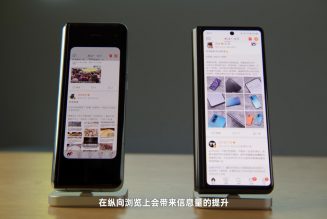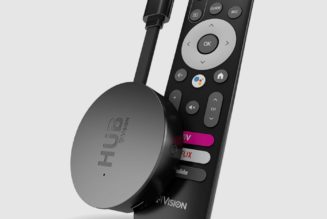
Hello again, friends. The Processor newsletter is back after a not-so-brief hiatus caused by the absolutely frenetic pace of hardware reviews this fall and a special run of Vergecast podcast episodes about those reviews. I’m really proud of those podcasts and if you haven’t caught them, I think it’s worth going back to give them a listen.
The big consumer tech news this week is Apple’s announcement that it will hold a ‘One More Thing’ event for November 10th. The going assumption — which I share — is that Apple will unveil the promised first Arm-based Apple silicon-powered Mac, mostly likely a laptop. In this very newsletter I’ve opined a few times on why this transition could be tricky and how Microsoft’s rougher ride in a similar transition could provide some lessons for Apple. Since the newsletter’s back, I’ll have more to say next week.
For today, I think I’d like to provide the service of just pointing out a few neat little things I’ve seen happen this fall hardware season. Specifically, I love it when products offer some kind of clever, subtle feature using technology that has been around for years and years. There are plenty of innovations based on hyper-advanced chips or sophisticated machine learning algorithms, but the features that make me smile are the ones that just required somebody to come up with new ways to use the parts we’ve already got.
First, it’s not new but it’s exemplary: there’s a new accessibility feature for the iPhone in iOS 14 that lets you double or triple tap the back of the phone to do stuff, like a virtual button. Chaim Gartenberg wrote about it last week. Apple may not have come up with this first, but its implementation is superb. Not only can you map those taps to standard features, but you can also use them to launch Shortcuts — so in effect you can make virtual buttons that can do anything. And of course, it’s an accessibility win to offer a different way to achieve common iPhone tasks.
I love this because so far as I can tell, all it really does is measure the accelerometer that’s been sitting in smartphones since forever. We’ve just been using them to detect switching from landscape to portrait, but there’s plenty of other things they could be used for if you just sat and thought about the possibilities (and, of course, if you can code them up). Google, for example, is using accelerometers to build out a global earthquake detection system with Android phones.
Here’s another little feature I love: the Pixel 5 automatically turns on reverse wireless charging for a brief time after you plug in a USB-C charger. On Samsung phones, you have to manually turn it on before flipping the phone over. I like the Pixel’s solution because it neatly solves the problem of charging your wireless earbuds without requiring any extra effort. It makes one cable charge two devices without any extra fuss.
One aside though: it’s kind of dumb that software tricks are required to activate reverse wireless charging in the first place. The basic wireless standard that won is Qi, but I feel like it’s stagnated — and in its place we are getting a bunch of different “embrace and extend” style innovations on top of of Qi.
The most recent is Apple’s MagSafe system for the iPhone 12. It is another example of using ingenuity and already-existing technologies to elegantly solve simple problems. The magnets in MagSafe align the charging coils for maximum efficiency with minimum effort (and yes, I know Palm did it first). Apple also added NFC to the mix, so that accessories and the phone can seamlessly identify each other.
That’s clever — and it’s the sort of thing I’d love to see built into a standard that all phones could use. Similarly, it seems like we’re getting proliferating wireless charging standards for fast charging: Apple, Google, OnePlus, and Samsung all use different methods for making their phones charge faster on a puck or dock. It’s frustrating.
Let’s end our brief tour of ingenious uses of basic technologies on a high note. A very high note: Sony’s PS5 controller appears to be a triumph of good design. We’ll need to use it for longer and fully review it to verify our early impressions, but oh boy is it a fun little gadget.
Andrew Webster wrote up some impressions, and the TL;DR is that it has haptics that are more advanced than any I’ve felt — in more ways than one. Firstly, the controller can make all sorts of subtle, discrete (and discreet!) taps that are tied to what’s happening in-game. You can really feel the difference when your character walks on a hard surface or a soft surface.
Second, the triggers have a mechanism for adding tension when you pull on them. There’s a motor attached to a corkscrew that’s geared up against the trigger; just look at the illustration in this post. It introduces a lot of new mechanics to games — or at least the possibility of them.
I got to briefly try the controller myself and I fully understand why everybody is so hyped up over a thing that’s so seemingly mundane. It’s just a very thoughtfully designed object that creates new experiences simply by creative use of simple components.
All of these features could have fallen flat. It’s not enough to have the neat idea, you have also have to have excellent execution. Today, just as a break, take a second to appreciate when those two things come together.
One last meta note about this newsletter, irregularly scheduled emails shall commence again, and I thank you for your patience and apologize for dropping off last month. I’ll be aiming for a couple per week on through to a Thanksgiving break.
Election news
There are lots of tech-related results from the election, and I’ve linked some of the big ones below. But of course the biggest tech-related story from the election is how platforms are reacting to misinformation — including misinformation from the president’s campaign itself.
Twitter restricted a Trump campaign official’s tweet alleging Philadelphia voter fraud, Facebook put warnings that votes are still being counted at the top of feeds, both Twitter and Facebook labeled a baseless Trump post suggesting Democrats manipulated ballot counts, Democrats called on Twitter to suspend Trump as election results file in, YouTube left a video up that seems like it ought to have come down, and more than I can fit in this space.
I asked Casey Newton to TL;DR all of it for us, and he told me the following. For more detailed thoughts — and to get them daily — you ought to subscribe to his new newsletter, Platformer.
Platforms seem to have largely succeeded in fighting the big wars of 2016: fighting the spread of misinformation from spammy, scammy “fake news” sites, and also making it harder for foreign actors to wage undercover influence operations. We may learn more later, but so far it does not seem like the 2020 election will have turned on either issue.
The 2020 platform war is still about misinformation, but this time it’s coming from the top: the president of the United States has repeatedly made premature claims of victory and cast doubt on the integrity of the election. On that front, I think Facebook and Twitter moved effectively — and with unusual confidence — in labeling the president’s posts. YouTube lagged way behind, with a label on election videos so vague as to be meaningless — and, I’d argue, false. (It says “Results may not be final.” There’s no “may” about it. They won’t be final for weeks!)
We can’t do a full report card until the results are in. So far I’d say the platforms did much better than 2016 — but if the president’s posts today are any indication, they still have a huge misinformation challenge to deal with in the weeks and months to come.
┏ Massachusetts passes ‘right to repair’ law to open up car data. As Adi Robertson notes, if this law holds up then it might for all intents and purposes end up being how this data is made available nationwide. So far, seems like it’s holding up and drivers will be able to access the telematics data in their cars freely with any compatible app.
┏ Portland, Maine has voted to ban facial recognition.
┏ Uber, Lyft drivers aren’t employees after all, California voters say.
┏ Uber and Lyft had an edge in the Prop 22 fight: their apps. Andrew Hawkins on the all-out campaign to keep gig workers classified as freelancers instead of employees. $200 millions was spent in addition to the in-app ads.
This isn’t the first time Uber wielded its app to score a political victory. In 2015, the company was feuding with New York City Mayor Bill de Blasio over his effort to limit the number of new ride-hail vehicles on the road. To marshal its user base to oppose the mayor, Uber added a “DE BLASIO” option that illustrated how ride requests could vanish and vehicles could slow to a crawl if the mayor’s proposal was approved.
Consoles
┏ The different strategies of Microsoft and Sony’s next-generation consoles. Here’s the TL;DR from Jay Peters, but his article goes deep on what we know now about each console’s strengths and weaknesses.
Picking between the next Xbox or PlayStation will be less about hardware and more about Microsoft’s and Sony’s philosophies about this generation of console games. With the Xbox Series X and S, you’ll have access to a lot of older games at launch, but we have to wait and see if actual next-gen games will make a convincing case to upgrade. Meanwhile, Sony is betting on an exclusives-focused strategy for the PS5 that worked well with the PS4, but that will only work out if Sony releases exclusives that are worth buying a PS5 to play.
┏ Here’s every game coming to PlayStation 5 and Xbox Series X at launch and beyond. Nick Statt has put together a very comprehensive list. If you were lucky enough to land a preorder of either console (I was not), save this page as a reference:
Here’s a list of every day-one game available on both systems, notably excluding titles like Call of Duty: Black Ops Cold War that launch shortly after launch day and will not be available by November 12th. Also, some games are noted as console exclusives despite having released on other platforms like the Nintendo Switch in the previous generation; we’re only focusing on whether a game is exclusive to either the PS5 or Xbox Series X / S, and timed console exclusives are treated the same as first-party permanent exclusives until a publisher or developer has a concrete cross-platform release date to share.
More from The Verge
┏ Dell XPS 13 (late-2020) review: greatness, refined. Monica Chin has all the details on the Tiger Lake processor bump for one of our favorite laptops of 2020:
So overall, the XPS 13 is still an excellent laptop. It’s still one of the best you can buy. But I’m not as starstruck as I was at the beginning of this year, because the competition is creeping up. Zenbooks, Swifts, Yogas, Envys, and Spectres have all made strides in design, build, nifty features, and performance this year — and there are ARM-based Macbooks on the way. There are quite a few releases on the horizon that are looking more and more like the XPS 13. This is the best laptop of 2020 with the fewest compromises and the fewest risks. But Dell will need to stay creative if it wants to keep XPS at the top of the stack in 2021.
┏ T-Mobile will pay $200 million to settle FCC investigation into misuse of phone subsidies. Jacob Kastrenakes explains how before it was acquired by T-Mobile, Sprint engaged in some pretty shady behavior.
Instead, Sprint continued collecting subsidies for service it wasn’t providing for “an extended period of time.” Service providers are supposed to begin removing customers who stop using subsidized phone and internet plans after 30 days if they aren’t otherwise paying for it.
┏ Spotify is rolling out the ability to stream music from your Apple Watch without an iPhone nearby.
┏ Google says that Pixel 5’s display gap is ‘a normal part of the design’. Sorry, but this is weak sauce from Google. People who are spending the extra money for the fancier Pixel this year shouldn’t have weird gaps and seams on their phone.










